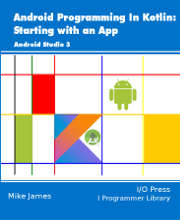| Android Programming In Kotlin: State Management |
| Written by Mike James | |||
| Monday, 11 March 2019 | |||
Page 2 of 2
There is no reason not to use the onCreate event handler in this way, but the system also fires an onResetoreInstanceState event when it is about to perform its own "automatic" restore of the UI for you. You can override this event handler if you want to keep the code that restores the app’s state kept out of the onCreate event handler. For example, you could have written: override fun onRestoreInstanceState( Do remember to call the super.onRestoreInstanceState if you want the system to restore the rest of the UI in the usual way. There are put and get methods for a range of standard data types. All simple types, byte, integer and so on, are supported, as are strings, arrays and other simple data structures. You can also create your own classes that can be stored in a Bundle by implementing the Parcelable interface. Notice you can save arbitrary data, and not just data for the layout. You can also create your own Bundle instance and make use of it for data storage, persistence and for transferring data to other parts of a program. There are many standard classes the Bundle doesn't support. In these cases you have to make your own arrangements to save data to storage. Often all you need to do to make sure that your app maintains its state between system restarts is to use the savedInstanceState Bundle object. This approach also reduces much of the practicality of lifecycle management to implementing the onSaveInstanceState and onRestoreInstanceState event handlers. This is so much simpler than having to worry about all of the different life cycle events. As an exercise, you can now go back to the iCalc example in Chapter 3 and make its display and current value persist through a screen rotate. Complex UI ElementsOne of the traps waiting for you is the problem of exactly what is automatically saved and restored. For example, at the start of this chapter we had the story of the app that lost the user’s form data when it was rotated. Given what we now know of the auto-saving and restoration of user modifiable UI elements, you might be wondering how this could happen? The answer is that the programmers of the app had probably grown accustomed to the automatic persistence of UI state and didn't bother to check that rotation had no effect. It did have an effect because the form was being downloaded from a website and displayed in a WebView control. A WebView control is persisted by the system, but it reloads the page when it is restored. This means that on a rotation the form was reloaded as empty and the user’s data was lost.
Advanced State ManagementFor completeness it is worth noting that there are many more approaches to maintaining state. Later you will need to discover how to store lots of user data locally for longer term persistence, and this is often enough to implement state management though a configuration change. There are also more advanced state management problems when you come to make use of Fragments, the subject of Android Programming: Mastering Fragments & Dialogs. In this case you can use retainedInstance to ask the system not to destroy an entire Fragment. This means that all of the data stored in the Fragment is retained even though the Activity may be removed from memory. This makes it possible to use a Fragment as a repository of state. The ultimate in making sure that things happen as you want is to handle the configuration change yourself. You can do this by making a change to the manifest. If you do this then it is up to you to make the changes needed when the onConfigurationChanged event occurs. You could, for example, opt to animate buttons and other UI objects into new positions or just ignore the need to reconfigure altogether. This is all advanced and for most applications you can get by using just the onSaveInstanceState and onRestoreInstanceState event handlers. Summary
Android Programming In Kotlin
|
|||
| Last Updated ( Wednesday, 13 March 2019 ) |




